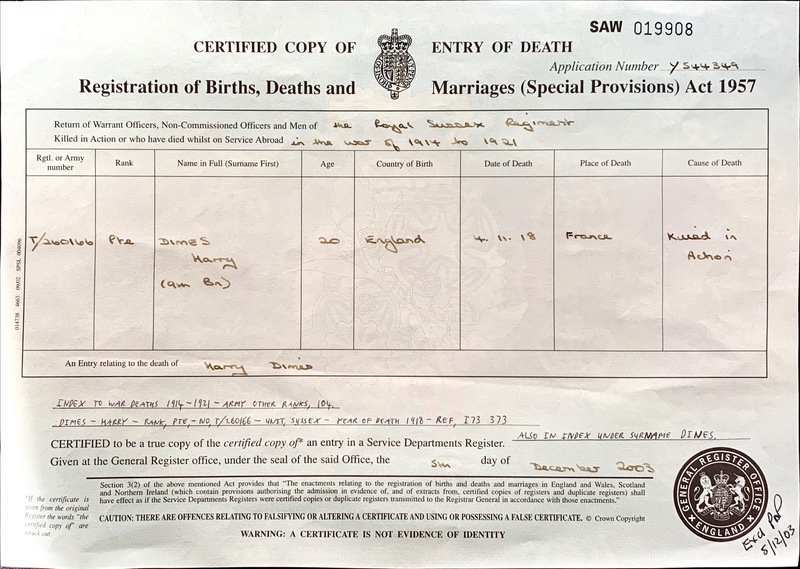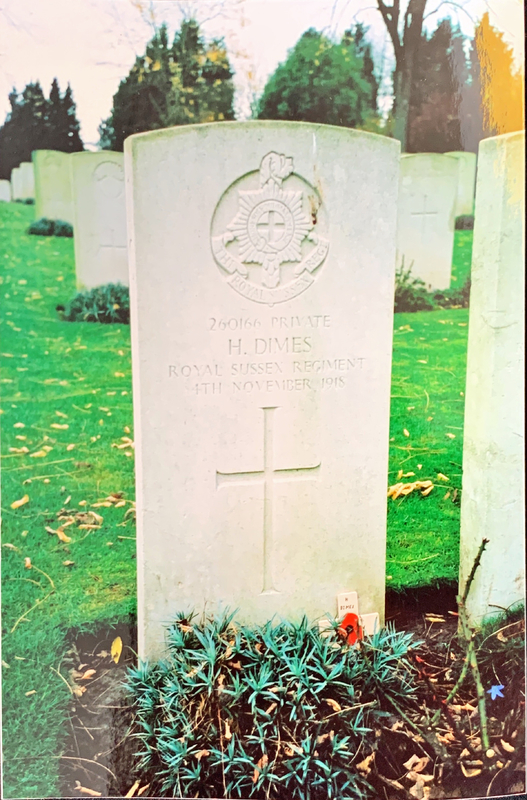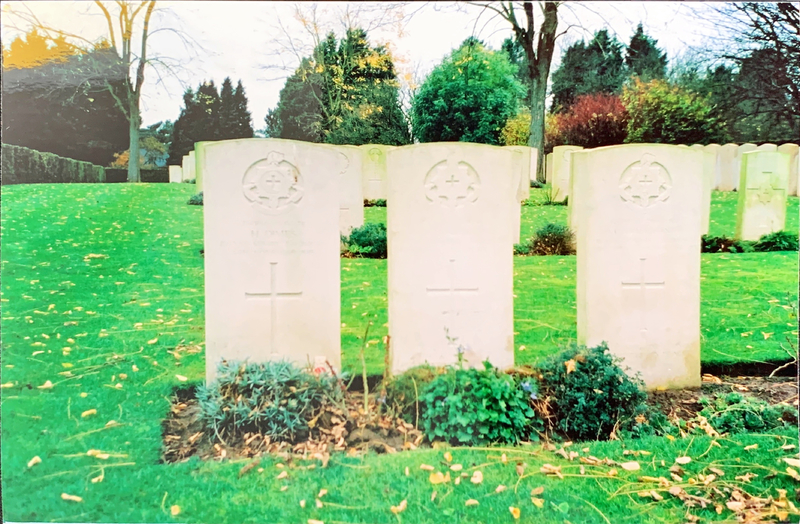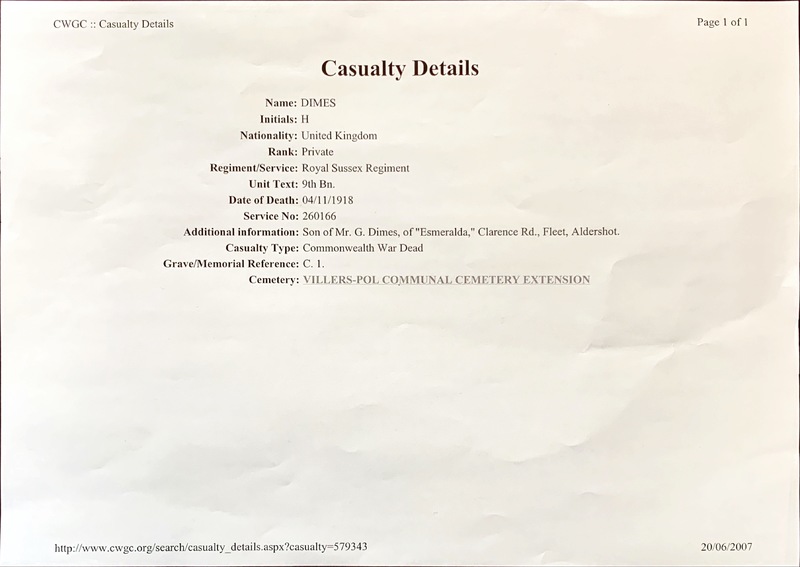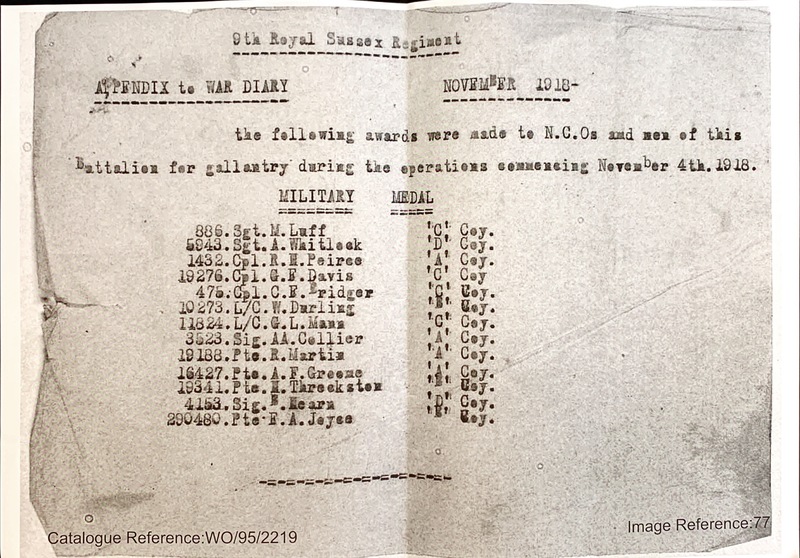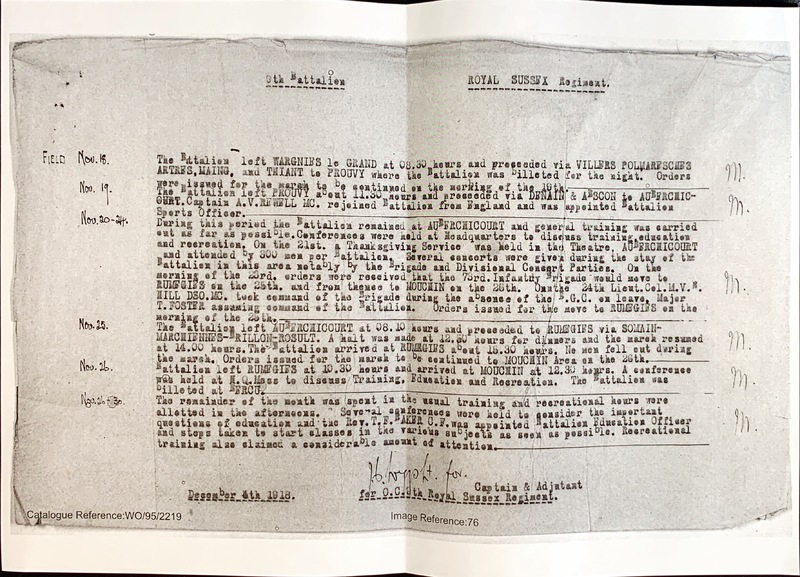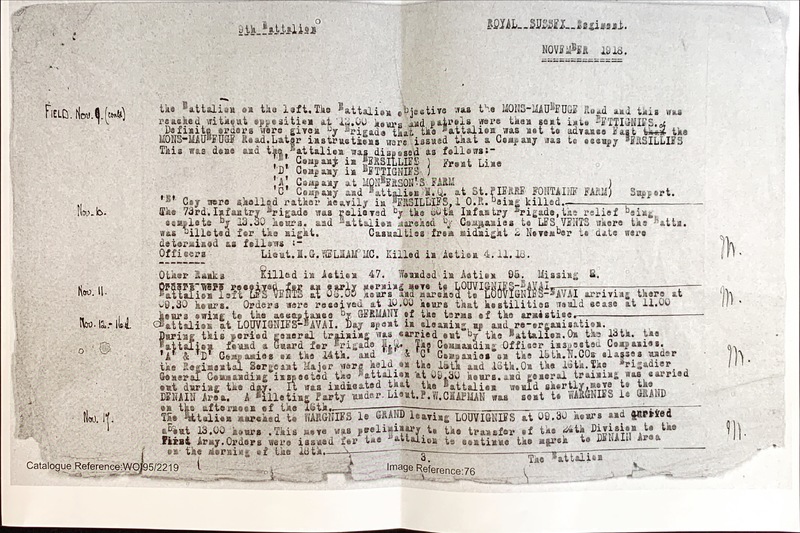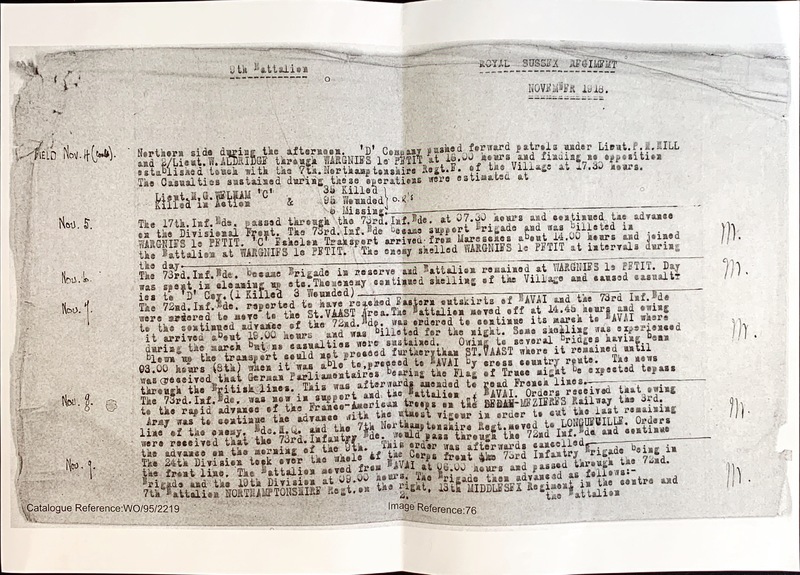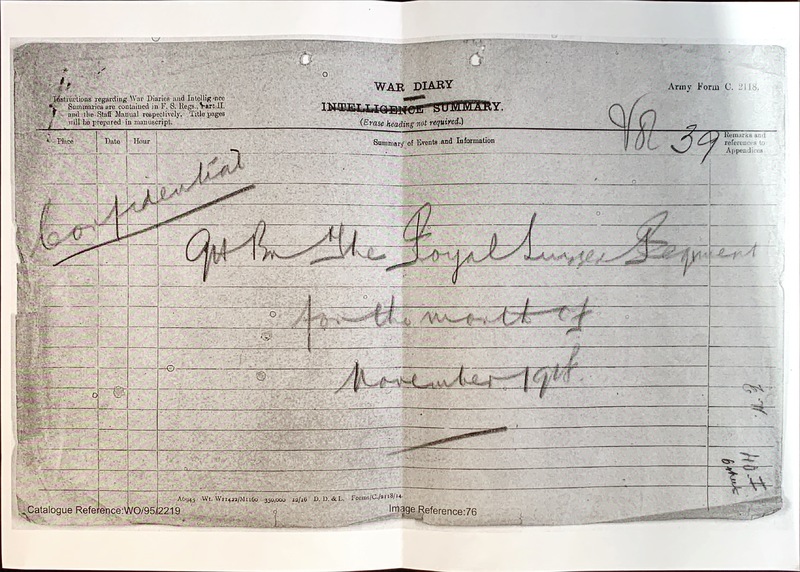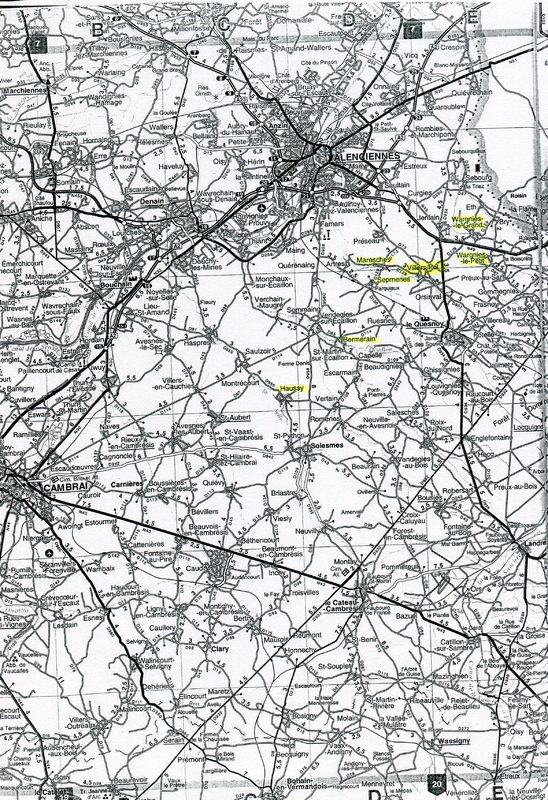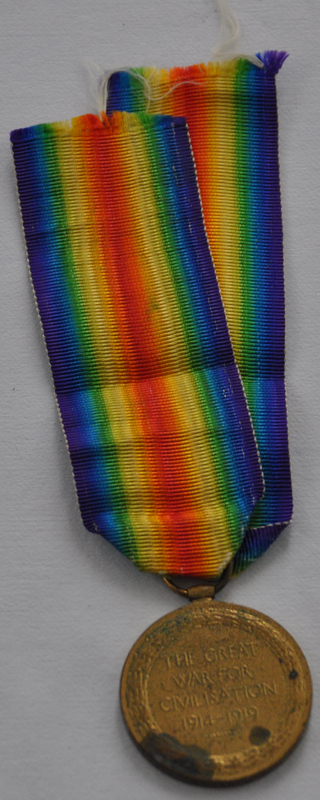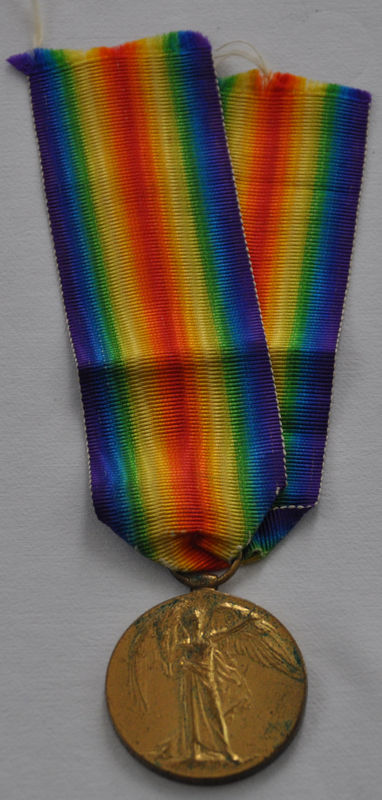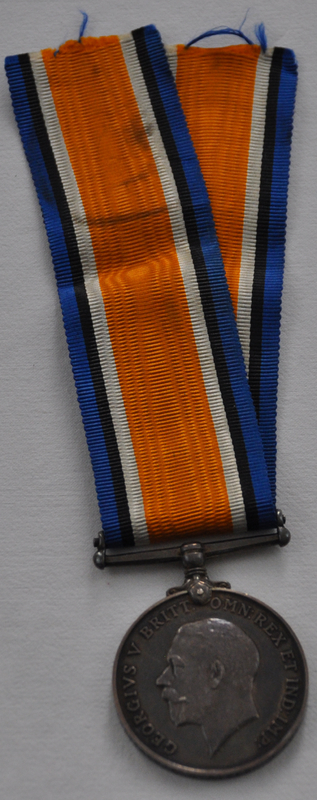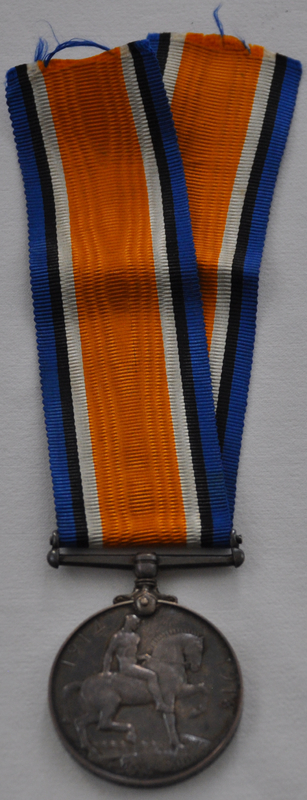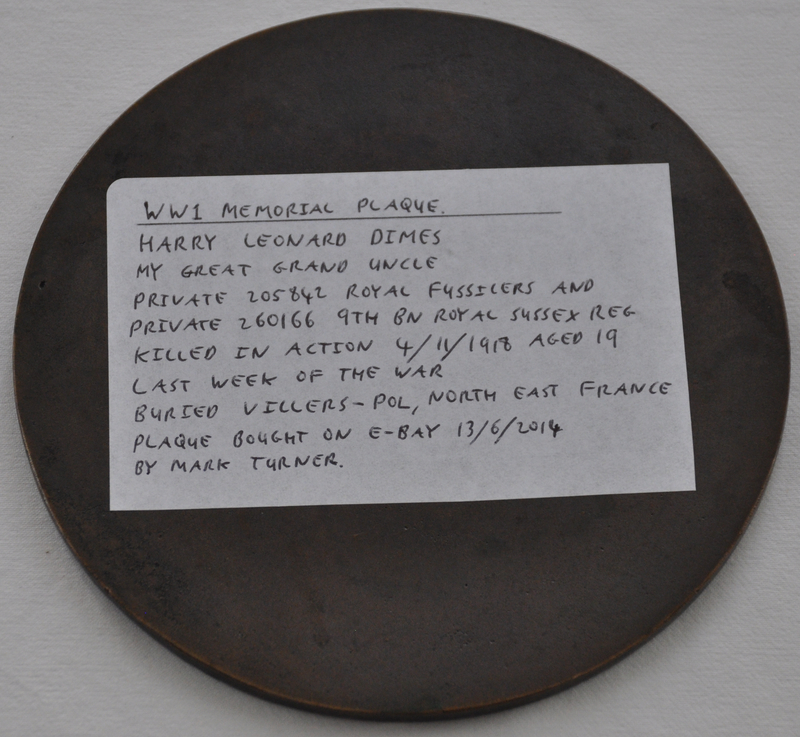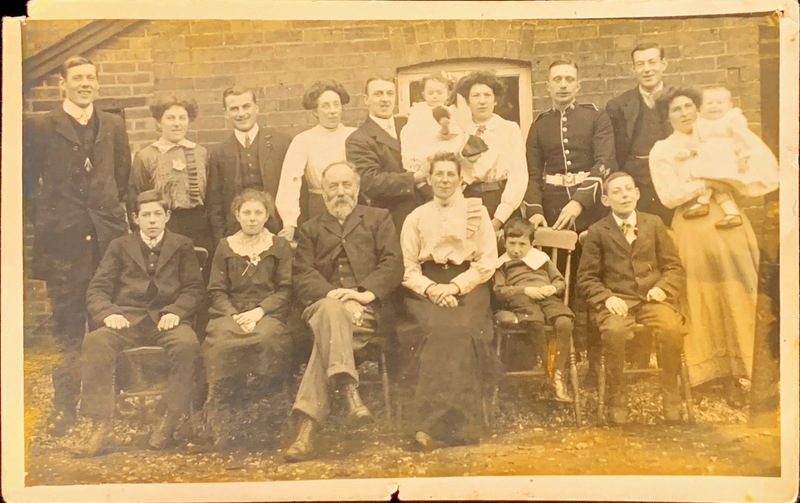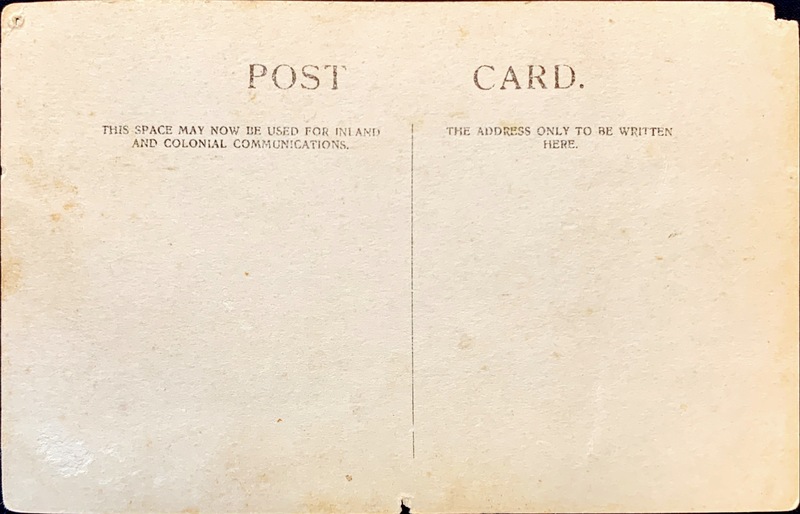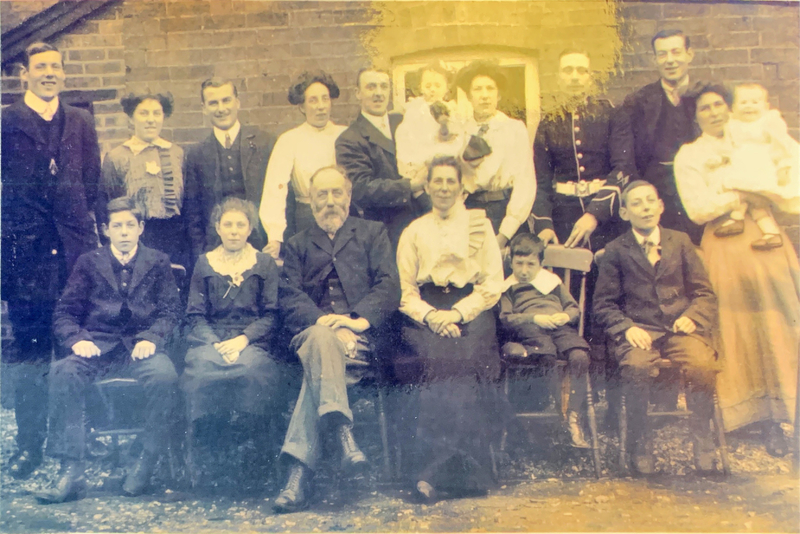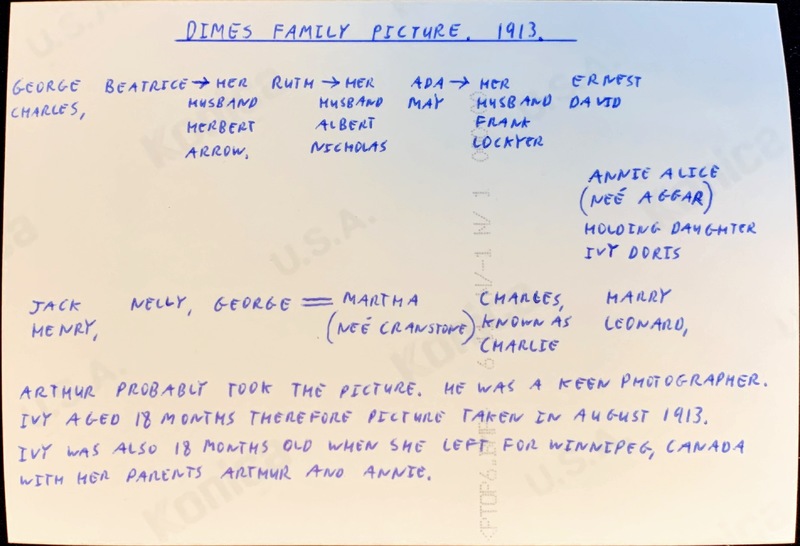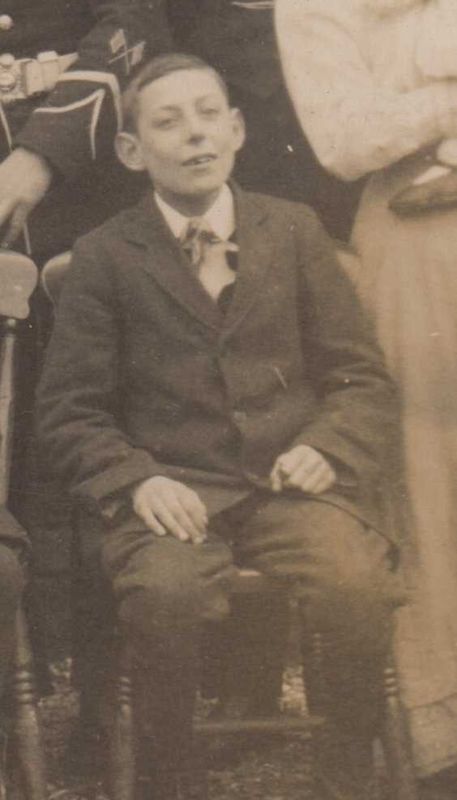Harry Leonard Dimes of Fleet, Hampshire
Item
Title
Harry Leonard Dimes of Fleet, Hampshire
Who?
Harry Leonard Dimes
Item(s)
1. Death certificate.
2. Close-up of H. Dimes' grave.
3. Shot of H. Dimes' gravestone in context of graveyard.
4. 2 pages from CWGC on H. Dimes.
5. War Diary (6 pages).
6. Modern map of France showing location of battle H. Dimes was involved in (possibly died there?).
7. 2 Medals, images of front and back of each (4 photos total).
8. Death penny for H. Dimes (front and back).
9. Dimes family photo (postcard, front and back).
10. Later, lower quality, photograph of the previous family photo postcard, printed on photographic paper, with writing on back detailing family members depicted.
11. Photograph of Harry Dimes, 1913 (aged 14).
2. Close-up of H. Dimes' grave.
3. Shot of H. Dimes' gravestone in context of graveyard.
4. 2 pages from CWGC on H. Dimes.
5. War Diary (6 pages).
6. Modern map of France showing location of battle H. Dimes was involved in (possibly died there?).
7. 2 Medals, images of front and back of each (4 photos total).
8. Death penny for H. Dimes (front and back).
9. Dimes family photo (postcard, front and back).
10. Later, lower quality, photograph of the previous family photo postcard, printed on photographic paper, with writing on back detailing family members depicted.
11. Photograph of Harry Dimes, 1913 (aged 14).
Story
Name: Harry Leonard Dimes
Rank: Private
Service Number and Unit: 205842 Royal Fusiliers
And Service Number and Unit: T/260166 9th Battalion Royal Sussex Regiment
Killed: 4th November 1918, aged 19
Born in April 1899 at ‘Esmeralda’ 183 Middle Street (now 194 Clarence Road), Fleet, Hampshire. Son of George and Martha Dimes, nee Cranstone. Harry’s father was a bricklayer who later owned his own building business. He had 5 brothers and 4 sisters, all born in Fleet. Ruth was born in 1883, Arthur was born in 1886, George Charles was born in 1887, Beatrice was born in 1890 (her twin, Gertrude, born in 1890, died 8 days old), Ada May was born in 1892, Ernest David was born in 1894, John Henry (aka Jack) was born in 1896, Nellie Dorothy was born in 1901, and Charles Frederick (aka Charlie) was born in 1907.
The verbal account and family story told to me by my mother and grandmother (Harry was my grandmother’s uncle) is as follows:
“Harry was serving in France during the Great War. At one stage, he took part in the Battle of the Somme. Apparently, he and another soldier were carrying a wounded officer on a stretcher back to their lines when he was shot in the back and killed. Harry died on the last day of the war, Armistice Day 11/11/1918.”
My Grandmother said there once existed a document detailing how and where Harry died. (Note: were detailed documents issued to the families or just a telegram saying their loved one had been killed?) This document unfortunately was destroyed many years ago.
Harry Leonard enlisted at Andover, Hampshire initially into the Royal Fusiliers. His service number was 205842 - Rank: Private.
The Commonwealth War Graves Commission states that Harry was killed 4/11/1918 serving with the 9th Battalion Royal Sussex Regiment, and his service number was 260166 – Rank: Private. Buried Villers-Pol communal cemetery extension. Grave/Memorial Ref: C1. Number of British burials from various regiments is 118. Of these 88 were killed on the 4/11/1918 and there are also 74 German burials.
Villers-pol is a small village commune surrounded by fields in north-east France between Valenciennes and Le Quesnoy and close to the Belgian border. I visited the grave of Harry Dimes on Sunday 11/11/2007; I think I was the first known family member to visit and my grandmother agreed.
Why did Harry serve with different regiments and why did he have different Service Numbers? Had one of the regiments sustained heavy casualties and was it normal to transfer soldiers or merge units?
The family story of Harry serving at one of the Somme battles may be true. The Germans launched their Spring Offensive along the Western Front beginning on 21/3/2018 to 18/7/1918. From what I have researched the 9th Battalion Royal Sussex Regiment were involved in the fighting during March and April. They were also involved with the Second Battle of the Sambre 4/11/1918. By this stage in the war the German Army had been pushed back towards Belgium and Germany.
I have obtained a copy of the War Diary and the Appendix to War Diary from the National Archives at Kew. Catalogue Reference: WO/95/2219. War Diaries were handwritten or typed documents providing a daily account of the activities of a unit on active service. Below is the War Diary for 9th Battalion Royal Sussex Regiment on the 4th November 1918. Note: the previous few days are worth a read as this also sets the scene and records the British advance from village to village. From Haussy to Bermerain then to Sepmeries and then Maresches.
Nov 4th
“Orders issued to Companies for attack through the 13th MIDDLESEX Regt. to take High Ground N. of WARGNIES le PETIT and WARGNIES le GRAND and to make good, if possible, the crossings over the RHONELLE River. ZERO Hour 05.30 hours. The advance was to be made through a creeping Barrage. The Battalion was disposed as follows: - ‘C’ Coy. On left. ‘A’ Coy. in centre. ‘B’ Coy. on right. ‘D’ Coy. in Support.”
“The march to the Assembly Positions was made through a good deal of enemy shelling particularly in the vicinity of VILLERS POL. Enemy Machine guns were very active whilst Companies were actually getting into their positions. A number of casualties were sustained before ZERO by these M.Gs. During the advance enemy artillery was not directed very much against front troops but M.Gs. were very numerous and caused a number of casualties particularly on High ground W. of Brick-field. The advance was successful but ‘A’ & ‘B’ Coys. were held up on the right by M.Gs. on both sides of the River until 11.00 hours when the enemy was forced to retire and these Coys. consolidated on the High ground W. of WARGNIES le PETIT.”
The War Diary for the rest of the day does continue.
From reading the War Diary from the 5th to the 11th November, the fighting on the 4th November was the last attack the Regiment fought. Very sad that Harry was killed during the last week of the war.
I obtained a copy of Harry Dimes’ death certificate from the London Record Centre. (Reference ‘Index to war deaths 1914-1921 – army other ranks, 104. ‘Dimes-Harry-Rank, PTE,-No, T/260166 – Unit, Sussex – year of death 1918 – ref, 173 373.’ He was also listed in the index under the surname DINES.
The death certificate says very little:
Army Number: T/260166, Rank: Pte, Name: Dimes Harry (9th Bn), Age: 20, Country of Birth: England, Date of Death: 4/11/18, Place of Death: France, Cause of Death: Killed in Action.
Note: 60% of First World War soldiers’ Service Records were destroyed as a result of enemy bombing in 1940. Unfortunately, Harry’s records have been destroyed.
The family story that Harry was killed on Armistice Day 11/11/1918 is incorrect as the correct date was 4/11/1918. However, maybe the family were informed by telegram of his death on Armistice Day? Is it reasonable to believe during that time it would take a week for the news to reach home? Was he really carrying a stretcher and shot in the back, could this just be propaganda or made up by the family?
Medal Index Card shows that Harry was awarded the British War Medal and the Victory Medal. First World War medals were engraved around the rim with the Service Number, Rank, Initial, Surname, and Name of Regiment. The engraving on his two medals reads: 205842 PTE H DIMES R FUS. (PTE means rank of Private abbreviated).
When service personnel died as a result of the war, the next of kin were sent, by post, a ‘Memorial Plaque’ also known as a ‘Bronze Memorial’, ‘Dead Man’s Medal’ or ‘Death Penny’. The Memorial Plaque is a bronze plaque approximately 12 cms or 4.75 inches in diameter with the name of someone who died serving with the British and Empire forces and inscribed ‘He died for freedom and honour’. They were posted out from 1919 with a Scroll and a ‘King’s Message’ containing a facsimile signature of King George V. The plaques and scrolls were produced to commemorate those that gave their lives and to acknowledge their sacrifice. They were intended to give the close family a tangible memorial of their lost loved one.
I luckily managed to purchase Harry’s Memorial Plaque on the online auction site eBay on 13/6/2014. Four years previous I had created a ‘save search’ which read ‘WW1 plaque Dimes’ and in 2014 I received an email from eBay which read “We have found what you have been looking for.” I contacted the seller but he didn’t have any further information only that he had bought it in a box of various items from an auction in Blackburn. How it managed to be there I have no idea. It was definitely my Harry Dimes as he was the only one with this name that had died.
The inscription on the Fleet, Hampshire War Memorial reads: “H Dimes, PTE, R Fus” along with the name of his older brother, George Charles Dimes, who was also killed in the war serving with the Royal Garrison Artillery. His brother Ernest David Dimes, who served with the Hampshire Regiment, survived the war. Harry’s eldest brother Arthur Dimes and his family had emigrated to Winnipeg in Canada before the war and worked as a tin smith/sheet metal worker for the Canadian Pacific Railway. This job was a reserved occupation during the war.
It’s interesting to note that Harry died whilst serving with the Royal Sussex Regiment and this is inscribed on his grave stone and on death certificate, yet his medals and inscription on the Fleet War Memorial reads Royal Fusiliers.
Rank: Private
Service Number and Unit: 205842 Royal Fusiliers
And Service Number and Unit: T/260166 9th Battalion Royal Sussex Regiment
Killed: 4th November 1918, aged 19
Born in April 1899 at ‘Esmeralda’ 183 Middle Street (now 194 Clarence Road), Fleet, Hampshire. Son of George and Martha Dimes, nee Cranstone. Harry’s father was a bricklayer who later owned his own building business. He had 5 brothers and 4 sisters, all born in Fleet. Ruth was born in 1883, Arthur was born in 1886, George Charles was born in 1887, Beatrice was born in 1890 (her twin, Gertrude, born in 1890, died 8 days old), Ada May was born in 1892, Ernest David was born in 1894, John Henry (aka Jack) was born in 1896, Nellie Dorothy was born in 1901, and Charles Frederick (aka Charlie) was born in 1907.
The verbal account and family story told to me by my mother and grandmother (Harry was my grandmother’s uncle) is as follows:
“Harry was serving in France during the Great War. At one stage, he took part in the Battle of the Somme. Apparently, he and another soldier were carrying a wounded officer on a stretcher back to their lines when he was shot in the back and killed. Harry died on the last day of the war, Armistice Day 11/11/1918.”
My Grandmother said there once existed a document detailing how and where Harry died. (Note: were detailed documents issued to the families or just a telegram saying their loved one had been killed?) This document unfortunately was destroyed many years ago.
Harry Leonard enlisted at Andover, Hampshire initially into the Royal Fusiliers. His service number was 205842 - Rank: Private.
The Commonwealth War Graves Commission states that Harry was killed 4/11/1918 serving with the 9th Battalion Royal Sussex Regiment, and his service number was 260166 – Rank: Private. Buried Villers-Pol communal cemetery extension. Grave/Memorial Ref: C1. Number of British burials from various regiments is 118. Of these 88 were killed on the 4/11/1918 and there are also 74 German burials.
Villers-pol is a small village commune surrounded by fields in north-east France between Valenciennes and Le Quesnoy and close to the Belgian border. I visited the grave of Harry Dimes on Sunday 11/11/2007; I think I was the first known family member to visit and my grandmother agreed.
Why did Harry serve with different regiments and why did he have different Service Numbers? Had one of the regiments sustained heavy casualties and was it normal to transfer soldiers or merge units?
The family story of Harry serving at one of the Somme battles may be true. The Germans launched their Spring Offensive along the Western Front beginning on 21/3/2018 to 18/7/1918. From what I have researched the 9th Battalion Royal Sussex Regiment were involved in the fighting during March and April. They were also involved with the Second Battle of the Sambre 4/11/1918. By this stage in the war the German Army had been pushed back towards Belgium and Germany.
I have obtained a copy of the War Diary and the Appendix to War Diary from the National Archives at Kew. Catalogue Reference: WO/95/2219. War Diaries were handwritten or typed documents providing a daily account of the activities of a unit on active service. Below is the War Diary for 9th Battalion Royal Sussex Regiment on the 4th November 1918. Note: the previous few days are worth a read as this also sets the scene and records the British advance from village to village. From Haussy to Bermerain then to Sepmeries and then Maresches.
Nov 4th
“Orders issued to Companies for attack through the 13th MIDDLESEX Regt. to take High Ground N. of WARGNIES le PETIT and WARGNIES le GRAND and to make good, if possible, the crossings over the RHONELLE River. ZERO Hour 05.30 hours. The advance was to be made through a creeping Barrage. The Battalion was disposed as follows: - ‘C’ Coy. On left. ‘A’ Coy. in centre. ‘B’ Coy. on right. ‘D’ Coy. in Support.”
“The march to the Assembly Positions was made through a good deal of enemy shelling particularly in the vicinity of VILLERS POL. Enemy Machine guns were very active whilst Companies were actually getting into their positions. A number of casualties were sustained before ZERO by these M.Gs. During the advance enemy artillery was not directed very much against front troops but M.Gs. were very numerous and caused a number of casualties particularly on High ground W. of Brick-field. The advance was successful but ‘A’ & ‘B’ Coys. were held up on the right by M.Gs. on both sides of the River until 11.00 hours when the enemy was forced to retire and these Coys. consolidated on the High ground W. of WARGNIES le PETIT.”
The War Diary for the rest of the day does continue.
From reading the War Diary from the 5th to the 11th November, the fighting on the 4th November was the last attack the Regiment fought. Very sad that Harry was killed during the last week of the war.
I obtained a copy of Harry Dimes’ death certificate from the London Record Centre. (Reference ‘Index to war deaths 1914-1921 – army other ranks, 104. ‘Dimes-Harry-Rank, PTE,-No, T/260166 – Unit, Sussex – year of death 1918 – ref, 173 373.’ He was also listed in the index under the surname DINES.
The death certificate says very little:
Army Number: T/260166, Rank: Pte, Name: Dimes Harry (9th Bn), Age: 20, Country of Birth: England, Date of Death: 4/11/18, Place of Death: France, Cause of Death: Killed in Action.
Note: 60% of First World War soldiers’ Service Records were destroyed as a result of enemy bombing in 1940. Unfortunately, Harry’s records have been destroyed.
The family story that Harry was killed on Armistice Day 11/11/1918 is incorrect as the correct date was 4/11/1918. However, maybe the family were informed by telegram of his death on Armistice Day? Is it reasonable to believe during that time it would take a week for the news to reach home? Was he really carrying a stretcher and shot in the back, could this just be propaganda or made up by the family?
Medal Index Card shows that Harry was awarded the British War Medal and the Victory Medal. First World War medals were engraved around the rim with the Service Number, Rank, Initial, Surname, and Name of Regiment. The engraving on his two medals reads: 205842 PTE H DIMES R FUS. (PTE means rank of Private abbreviated).
When service personnel died as a result of the war, the next of kin were sent, by post, a ‘Memorial Plaque’ also known as a ‘Bronze Memorial’, ‘Dead Man’s Medal’ or ‘Death Penny’. The Memorial Plaque is a bronze plaque approximately 12 cms or 4.75 inches in diameter with the name of someone who died serving with the British and Empire forces and inscribed ‘He died for freedom and honour’. They were posted out from 1919 with a Scroll and a ‘King’s Message’ containing a facsimile signature of King George V. The plaques and scrolls were produced to commemorate those that gave their lives and to acknowledge their sacrifice. They were intended to give the close family a tangible memorial of their lost loved one.
I luckily managed to purchase Harry’s Memorial Plaque on the online auction site eBay on 13/6/2014. Four years previous I had created a ‘save search’ which read ‘WW1 plaque Dimes’ and in 2014 I received an email from eBay which read “We have found what you have been looking for.” I contacted the seller but he didn’t have any further information only that he had bought it in a box of various items from an auction in Blackburn. How it managed to be there I have no idea. It was definitely my Harry Dimes as he was the only one with this name that had died.
The inscription on the Fleet, Hampshire War Memorial reads: “H Dimes, PTE, R Fus” along with the name of his older brother, George Charles Dimes, who was also killed in the war serving with the Royal Garrison Artillery. His brother Ernest David Dimes, who served with the Hampshire Regiment, survived the war. Harry’s eldest brother Arthur Dimes and his family had emigrated to Winnipeg in Canada before the war and worked as a tin smith/sheet metal worker for the Canadian Pacific Railway. This job was a reserved occupation during the war.
It’s interesting to note that Harry died whilst serving with the Royal Sussex Regiment and this is inscribed on his grave stone and on death certificate, yet his medals and inscription on the Fleet War Memorial reads Royal Fusiliers.
When?
1914-1918
Where?
France
Contributor
Mark Turner, Great Grandson to Arthur Dimes. Arthur Dimes was Harry Leonard’s eldest brother. Therefore, Harry Leonard Dimes is my Great Grand Uncle.
Collection Day
Fleet Library & Learning Centre, 09/11/2018
This item was submitted on April 18, 2019

